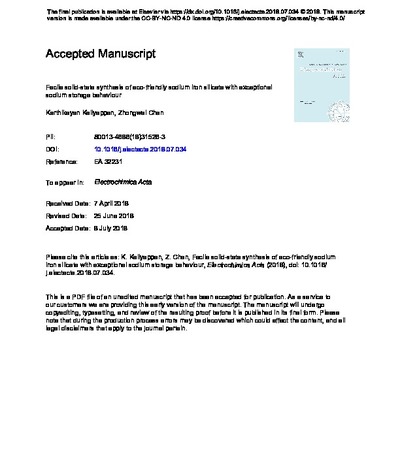UWSpace will be migrating to a new version of its software from July 29th to August 1st. UWSpace will be offline for all UW community members during this time.
Facile solid-state synthesis of eco-friendly sodium iron silicate with exceptional sodium storage behaviour
| dc.contributor.author | Kaliyappan, Karthikeyan | |
| dc.contributor.author | Chen, Zhongwei | |
| dc.date.accessioned | 2018-11-15 14:56:40 (GMT) | |
| dc.date.available | 2018-11-15 14:56:40 (GMT) | |
| dc.date.issued | 2018-09-01 | |
| dc.identifier.uri | https://dx.doi.org/10.1016/j.electacta.2018.07.034 | |
| dc.identifier.uri | http://hdl.handle.net/10012/14148 | |
| dc.description | The final publication is available at Elsevier via https://dx.doi.org/10.1016/j.electacta.2018.07.034 © 2018. This manuscript version is made available under the CC-BY-NC-ND 4.0 license https://creativecommons.org/licenses/by-nc-nd/4.0/ | en |
| dc.description.abstract | It is crucial to develop stable energy sources for rechargeable sodium-ion batteries using simple synthesis methods. Herein, we report a facile route for synthesizing phase-pure carbon-coated Na2FeSiO4 polyanionic cathodes using conventional solid-state methods at 700 °C under inert atmosphere. X-ray diffraction results reveal that there are no impurities in the highly crystalline Na2FeSiO4 particles, resulting from the heat of combustion provided by the organic chelating agent. The electrochemical behaviour of Na2FeSiO4 particles is tested within 1.5–4.5 V at 0.25 C. The Na2FeSiO4 cathode delivered 119 mAh g−1 at 0.25 C and maintained ∼85% of its initial capacity after 200 cycles after activation process. Even at high current densities of 3.5 C, the material outperforms other orthosilicates-based cathodes reported with capacities of 55 mAh g−1 discharge capacity along with ∼80% retention after 1000 cycles. The enhanced performance of carbon-coated Na2FeSiO4 particles is ascribed to the improved electronic conductivity by the incorporation of carbon and the presence of void space between the particles. This void space contains more electrolytes and eliminates the stress formed during the cycling process, thus improving stability even at high rates. This is the first report on obtaining phase pure metal orthosilicate material with negligible impurities using simple solid-state method along with such exponential electrochemical performances. | en |
| dc.description.sponsorship | Natural Sciences and Engineering Research Council of Canada | en |
| dc.language.iso | en | en |
| dc.publisher | Elsevier | en |
| dc.rights | Attribution-NonCommercial-NoDerivatives 4.0 International | * |
| dc.rights.uri | http://creativecommons.org/licenses/by-nc-nd/4.0/ | * |
| dc.subject | High rate performance | en |
| dc.subject | NaFeSiO | en |
| dc.subject | Polyanion cathode | en |
| dc.subject | Sodium ion batteries | en |
| dc.subject | Solid state | en |
| dc.title | Facile solid-state synthesis of eco-friendly sodium iron silicate with exceptional sodium storage behaviour | en |
| dc.type | Article | en |
| dcterms.bibliographicCitation | Kaliyappan, K., & Chen, Z. (2018). Facile solid-state synthesis of eco-friendly sodium iron silicate with exceptional sodium storage behaviour. Electrochimica Acta, 283, 1384–1389. doi:10.1016/j.electacta.2018.07.034 | en |
| uws.contributor.affiliation1 | Faculty of Engineering | en |
| uws.contributor.affiliation2 | Chemical Engineering | en |
| uws.typeOfResource | Text | en |
| uws.typeOfResource | Text | en |
| uws.peerReviewStatus | Reviewed | en |
| uws.scholarLevel | Faculty | en |


